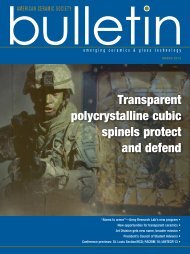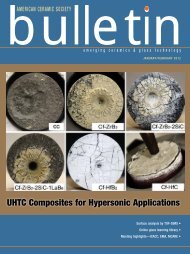American Ceramic Society Bulletin
American Ceramic Society Bulletin
American Ceramic Society Bulletin
You also want an ePaper? Increase the reach of your titles
YUMPU automatically turns print PDFs into web optimized ePapers that Google loves.
esearch briefs<br />
New class of optical fiber developed at Penn State; ZnSe waveguide<br />
cores open infrared spectrum<br />
Scientists at Pennsylvania State University<br />
report that they developed the<br />
first optical fiber made with a core of<br />
zinc selenide. The team is led by John<br />
Badding, professor of chemistry at PSU,<br />
with help from fellow researchers at the<br />
school’s Materials Research Institute<br />
and Department of Materials Science<br />
and Engineering, as well as from scientists<br />
at the Optoelectronics Research<br />
Centre at the University of Southampton<br />
(U.K.).<br />
Badding says in a PSU news release,<br />
“It has become almost a cliche to say<br />
that optical fibers are the cornerstone<br />
of the modern information age. These<br />
long, thin fibers, which are three times<br />
as thick as a human hair, can transmit<br />
over a terabyte – the equivalent of 250<br />
DVDs of information per second. Still,<br />
there always are ways to improve on<br />
existing technology. Glass has a haphazard<br />
arrangement of atoms. In contrast,<br />
a crystalline substance like zinc<br />
selenide is highly ordered. That order<br />
allows light to be transported over longer<br />
wavelengths, specifically those in<br />
the mid-infrared.”<br />
The group’s methods include a specially<br />
developed high-pressure chemical<br />
vapor deposition technique. “The highpressure<br />
deposition is unique in allowing<br />
formation of such long, thin, zinc<br />
selenide fiber cores in a very confined<br />
space,” Badding says in the release.<br />
According to the PSU release, “this<br />
new class of optical fiber allows for a<br />
more effective and liberal manipulation<br />
of light and promises to open the door<br />
to more versatile laser-radar technology.”<br />
Other applications include the<br />
development of improved surgical and<br />
medical lasers, better countermeasure<br />
lasers used by the military, and superior<br />
environment-sensing lasers for measuring<br />
pollutants and to detect the dissemination<br />
of bioterrorist chemical agents.<br />
New lighting uses also may be possible.<br />
ACerS member Venkatraman Gopa-<br />
lan, professor<br />
at Penn State’s<br />
Department of<br />
Materials Science<br />
and Engineering<br />
and the<br />
associate director<br />
for the Center<br />
for Optical<br />
Technologies, is<br />
a member of the<br />
research team.<br />
An email from<br />
Gopalan to the<br />
<strong>Bulletin</strong> provides<br />
some important<br />
context of their<br />
optical fiber<br />
discovery. He<br />
notes, “Infrared<br />
wavelength range<br />
is extremely<br />
important, and<br />
yet even the<br />
basic infrared<br />
technologies,<br />
such as optics,<br />
coatings, waveguides,<br />
lasers, and<br />
detectors, are in<br />
their infancy, as<br />
compared with<br />
technologies in<br />
the visible or<br />
telecon wavelengths.<br />
This development breathes<br />
new life into glass fibers that are usually<br />
infrared opaque beyond approximately<br />
2.5 microns wavelength.”<br />
Gopalan also predicts that these<br />
fibers could revolutionize many important<br />
areas of optics research, such as<br />
fiber-based guiding, imaging, spectroscopy<br />
and tunable lasers. “The deposition<br />
technique is versatile enough to<br />
imagine a whole family of important<br />
compound semiconductors making their<br />
way into fiber cores in the near future.<br />
Optical fibers may soon come with<br />
(a) Schematic of the HPCVD process, where a high-pressure precursor<br />
mixture is configured to flow into a capillary (left). When<br />
the capillary is heated, well-developed annular films are deposited.<br />
Unreacted precursors, carrier gas, and reaction byproducts<br />
are carried out of the fiber (right). (b) Diascopically illuminated<br />
optical micrograph from the side showing the transparent, uniform<br />
ZnSe fiber core. The deposited structures can have a uniform<br />
cross section for as long as 4 centimeter when made in a 10 centimeter<br />
long furnace. Note that cylindrical lensing effects magnify<br />
the interior tube diameter considerably in this view, making its<br />
400-nanometer diameter appear much larger than it is. (c) Crosssectional<br />
SEM image showing an overview of the silica cladding<br />
and ZnSe core. (d) A higher magnification SEM image of the<br />
nearly completely filled core. Scale bars: (b) 50 micrometer, c) 50<br />
micrometer, d) 5 micrometer.<br />
many flavors and functions well beyond<br />
what glass can do,” writes Gopalan.<br />
Researcher team member Anna Peacock<br />
remarks on her website that, “ultrafast<br />
all-fibrer optical switches will reduce<br />
costs and improve efficiency of communications<br />
systems, whilst laser sources,<br />
which operate in the mid-infrared, can<br />
be used for environmental sensing and<br />
medical applications. The incorporation<br />
of the active semiconductor component<br />
into the fiber geometry provides an<br />
important step toward seamlessly linking<br />
semiconductor photonics with existing<br />
20 <strong>American</strong> <strong>Ceramic</strong> <strong>Society</strong> <strong>Bulletin</strong>, Vol. 90, No. 4<br />
(Credit: J. Badding, PSU; Advanced Materials.)






